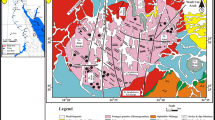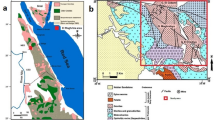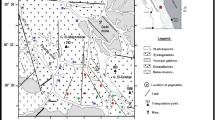Abstract
There are two main granitic rocks cropping out in the study area: 1) the syn-orogenic granites are moderately weathered, jointed, exfoliated and characterized by low relief. These rocks are subdivided into tonalite and granodiorite. They are essentially composed of plagioclase, quartz, biotite, hornblende and potash feldspar; and 2) the post-orogenic granites, characterized by high relief terrain and represented by monzogranite, syenogranite and alkali granite. The monzogranites suffered hydrothermal alteration in particular along joints, faults, shear zones and fractures, which recorded the highest values of radioactivity, reflecting the role of post-magmatic alteration processes in the enhancement of radioactivity. The hydrothermal alteration (desilicification and hematitization) resulted in the formation of mineralized (altered) granites. The altered granites are enriched in TiO2, Al2O3, FeOT, MnO, MgO, Na2O, Rb, Sr, Y, Zr, Zn, Ga and Co and depleted in SiO2, CaO, P2O5, Nb, Pb, Cu, Ni and Cr relative to the fresh monzogranite. The investigated granites contain basic xenoliths as well as pockets of pegmatites. Perthites, quartz, plagioclase and sometimes biotite, represent the essential constituents. Some accessory minerals like zircon are metamicted reflecting their radiogenic nature. The alkali granites are characterized by the presence of aegirine, rebeckite and arfvedsonite. Both syn- and post-orogenic granites show some variations in their bulk chemical compositions. The older granitoids are metaluminous and exhibit characteristics of I-type granites and possess an arc tectonic environment. On the other hand, the younger granites are peraluminous and exhibit the characteristics of post-collisional granites.It is interpreted that radioactivity of the studied rocks is mainly controlled by both magmatic and post-magmatic activities. Frequently, the post-orogenic granites host zoned and unzoned pegmatite pockets. Some of these pockets anomalously attain high radioactivity. The syenogranites and the pegmatites are characterized by high contents of SiO2 and K2O and low CaO and MgO. They have transitional characters from highly fractionated calc-alkaline to alkaline. The alkali granites related to A2-subtype of A-type granites. The post-orogenic granites were originated from magma of dominant crustal source materials and related to post-collisional setting under extensional environment.
Similar content being viewed by others
References
Abdel Karim A.M. (1992) Petrology of Late Precambrian Younger Granites from Southwest Sinai [M]. pp.267–272. Ismailia.
Abu El Enen M.M. (1989) Geological and Geochemical Studies on the Granitoid Rocks of Wadi Seih Area, Southwest Sinai [D]. Mansoura Univ. Egypt.
Akaad M.K., Nowier A.M., and Kotb H. (1979) Geology and petrochemistry of the granitic association of the Arbian Desert Orogenic belt of Egypt between 25°53′ and 26°30′ N [J]. Delta J. Sci. 3, 107–151
Akkad M.K. and Noweir A.M. (1980) Geology and lithostratigraphy of the Arabian Desert oroginic belt of Egypt between latitudes 25°35′ and 26°30′ N. In Evolution and Mineralization of the Arabian-Nubian Shield (eds. Cooray P.G. and Tahoun S.A.) [M]. Inst. Appl. Geol. Bull. Jeddah, Saudi Arabia. 4, 127–135.
Azzaz S.A. (1993) Petrogensis of granitoid rocks of Wadi Baba area, Southern Sinai, Egypt [J]. Earth Sci. 6, 79–98.
Barker F. (1979) Trondhjemites, definition, environment and hypotheses of origin. In Trondhjemites, Dacites and Related Rocks (ed. Barker ) [M]. Developments in Petrology, Elsevier Publ. Co. Amsterdam.
Bucanan M.S. (1982) The geochemistry of some igneous rock series [J]. Geochim. et Cosomochim. Acta. 9, 101–137.
Cameron E.N., Jahns R.H., McNair A.H., and Page L.R. (1949) Internal Structure of Granitic Pegmatites [D]. pp.115. Econ. Geol. Monograph.
Castro A., Moreno V.I., and Rosa J.D. de la (1991) H-type (Hybrid) granitoids: a proposed revision of the granite type classification and nomenclature [J]. Earth Sci. Rev. 31, 237–25.
Chappell B.W. and White A.J.R. (1974) Two contrasting granite types [J]. Pacific Geol. 8, 173–174.
Condie K.C. (1973) Archean magmatism and crustal thickening [J]. Geol. Soc. Am. Bull. 84, 2981–2992.
Cox K.G., Bell J.D., and Pankhurst R.J. (1979) The Interpretation of Igneous Rocks [M]. pp.414. William Clowes London, Britain.
Cuney M. (1987) Metallogenesis of Uranium Deposits [M]. IAEA, Vienna.
Cuney M., Leorty J., Valdiviezo P.A., Daziano C., Gamba M., Zarco J., Morello O., Ninci C., and Molina P. (1989) Geochemistry of the uranium mineralized Achala Granitic Complex, Argentina: comparison with Hercynian peraluminous leucogranites of Western Europe. In Metallogensis of Uuranium Deposits [M]. pp.211–232. Vienna.
Debon F. and Le Fort P. (1983) Chemical-mineralogical classification of the common plutonic rocks and associations [J]. Trans. R. Soc. Edinbrugh (Earth Sci.). 73, 135–149.
El Aassey E., Shazly A.G., Hussein H.A., Heikal T.S., and El Galy M.M. (1997) Pegmatites of Nuweiba-Dahab area, West Gulf of Aqaba, Sinai, Egypt. In Field Aspects, Mineralogy, Geochemistry and Radioactivity [C]. pp.139–151. The third Conf. on Geochemistry, Alex. Unv.
El Bouseily A.M. and El Sokkary A.A. (1975) The relation between Rb, Ba and Sr in granitic rocks [J]. Chem. Geol. 16, 207–219.
El-Gaby S. (1975) Petrochemistry and geochemistry of some granites from Egypt [J]. Neues Jb. Minal. Abht. 2, 147–189.
El-Gaby S. Lists F.K., and Tehrani R. (1988) Geology, evolution and metallogenesis of the Pan African belt in Egypt, In The Pan African Belt of Northeast Africa and Adjacent Areas; Tectonic Evolution and Economic Aspects of Late Proterozoic Orogeny (eds. El-Gaby S. and Greiling R.O.) [M]. Vieweg und Sohn., Braunschweig.
El-Gammal E.A.E. (1986) Geology of the Granitoid Rocks of the Northwestern Part of the Basement Rocks in Sinai, Egypt [D]. Al-Azhar Univ., Egypt.
El-Metwally A.A. (1993) Microgranular enclaves in the Pan African I-type granites from Sinai massif. Petrology, mineralogy and geochemistry [J]. J. African Earth Sci. 17, 95–110.
El-Mowafy A.A. (1994) Geology and Radioactivity of Southwestern Nuweiba Area, Sinai, Egypt [M]. pp.203. Mansoura Univ, Mansoura, Egypt.
El-Mowafy A.A. (1998) Geological, Petrographical and Radioactivity Studies of Gabal Um Zariq-Wadi Kid Area. Southeastern Sinai, Egypt [D]. pp.291. Mansoura Univ., Egypt.
El-Ramly M.F. (1972) A new geological map for the basement rock in eastern and southwestern Desert of Egypt: scale 1:100000 [J]. Annals Geol. Surv. Egypt. 2, 1–18.
El Ramly M.F. and Akaad M.K. (1960) The basement complex in the Central Eastern Desert of Egypt between latitudes 24°30′ and 25°40′ N [C]. Geol. Surv. Egypt, Paper. No. 8, 35.
Ekwere S.J. (1985) Li, F and Rb contents and Ba/Rb and Rb/Sr ratio as indicators of postmagmatic alteration and mineralizartion in the granitic rocks of the Banke and Ririwai younger granite complexes, Northern Nigeria [J]. Mineral Deposita. 20, 89–93.
El Sheshtawy Y.A. (1984) Petrographical and Geochemical Studies of Granitic Rocks Around Wadi El Sheikh, Southwestern Sinai, Egypt [D]. Al Azhar Univ., Cairo, Egypt.
Exley C.S. (1976) Observations on the formation of kaolinite in the St. Austell granite, Corn wall [J]. Clay Mineral. 11, 51–63.
Essawy M.A. and Hassan M.A. (1977) The occurrence of prehnite in uralitized gabbros from Egypt [J]. Verh. Geol. B.A.S. 405–406.
Greenberg J.K. (1981) Characteristics and origin of Egyptian younger granites [J]. Geol. Soc. Amer. Bull. 92, 749–840.
Hassan M.A. and Hashad A.H. (1990) Precambrian Egypt. In Geology of Egypt (ed. Said R.) [M]. pp.734. Balkema Publications, Netherlands.
Hashad A.H. (1980) Present status of geochemical data of the Egyptian Basement Complex. Symp. In On the Evolution and Mineralization of the Arabian Nubian Shield [M]. pp.31–46. King Abdulaziz Univ., Jeddah.
Hemly J.J. and Jones W.R. (1964) Chemical aspects of hydrothermal alteration with emphasis on hydrogen metasomatism [J]. Econ. Geol. 59, 538–569.
Hussein A.A., Ali M.M., and EL-Ramly M.F. (1982) A proposed new classification of the granites of Egypt [J]. Volcano Geotherm Resear. 14, 187–198.
Irvine I.N. and Baragar W.R.A. (1971) A guide to the chemical classification of common volcanic rocks [J]. Can. J. Earth Sci. 81, 523–548.
Kovalenko V.I. (1978) The genesis of rare metal granitoids and related ore deposits. In Metallization Associated With Acid Magmatism [M]. pp.235–248. Czechoslovakia Geological Survey, Prague.
Leroy J. (1978) The Margnac and Fanay uranium deposits of the La Crouzille District (Western Massif Central, France): Geologic and fluid inclusion studies [J]. Econ. Geol. 73, 1611–1634.
Liew T., Finger F., and Hock V. (1989) The molybdenium granitoid plutons of Austria chemical isotropic studies bearing on their environmental setting [J]. Chem., Geol. 76, 41–55.
Maniar P.D. and Piccoli P.M. (1989) Tectonic discrimination of granitoids [J]. Geol. Soc. Am. Bull. 101, 635–643.
Meyer C. and Hemley J.J. (1967) Wall rock alterations. In Geochemistry of hydrothermal Ore Deposits (ed. Barnes H.G.) [M]. pp.166–235. Winston Inc., New York.
Middlemost E.A.K. (1985) Magmas and Magmatic Rocks [M]. Longman Group Ltd., Essex.
Nasbitt H.W. and Young G.M. (1989) Formation and diagenesis of weathering profiles [J]. Journal of Geology. 97, 129–147.
Neiva A.N., Neiva T.M., and Parry S.J. (1987) Geochemistry of the granitic rocks and their minerals from Serrada Estrela, Central Portugual [J]. Geochimica et Cosmochimica Acta. 51, 439–454.
Nockolds S.R., Knox R.W.O.B., and Chinner G.A. (1979) Petrography for Students [M]. pp.427. Great Bretain, Fakenham Press, Norfolk.
Nockolds S.R. (1954) Average chemical composition of some igneous rocks [J]. Geol. Soc. Amer. Bull. 62, 1007–1032.
Pearce J.A. (1996) Sources and Settings of Granitic Rocks (Episodes 19) [M]. pp.120–125.
Pearce J.A., Harris N.B.W., and Tindle A.G. (1984) Trace element discrimination diagrams for the tectonic interpretation of granitic rocks [J]. J. Petrol. 25, 956–983.
Ramsay C.R. (1986) Specialized felsic plutonic rocks of the Arabian Shield and their precursors [J]. J. African Earth Sci. 4, 153–168.
Raguin E. (1976) Geologie du Granite [M]. pp.275. Paris, New York, Barcelone, Milan.
Rogers J.J.W. and Greenberg J.K. (1981) Summary of Recent Work on Egyptian Younger Granites [M]. pp. 185–191. Ann. Geol. Surv. Egypt.
Sallam O.R. (2006) Geology and Uranium Potentiality of Gabal Shiekh El-Arab Area, South Sinai, Egypt [D]. Ain Shams Univ., Egypt.
Stacey J.S., Stoeser D.B., Greenwood W.R., and Fischer L.B. (1984) U-Pb zircon geochronology and geological evolution of the Halaban Al Amar region of the Eastern Arabian Shield, Kingdum of Saudi Arabia [J]. J.Geol. Soc. London. 141, 1043–1055.
Stemprok M. (1979) Mineralized Granites and Their Origin (Episodes 3) [M]. pp.20–24.
Stern R.J. and Hedge C.E. (1985) Geochronologic and isotopic constraints on Late Precambrian crustal evolution in the Eastern Desert of Egypt [J]. Am. J. Sci. 285, 97–127.
Stern R.J. (1979) Late Precambrian Ensimatic Volcanism in the Central Eastern Desert of Egypt [D]. Thesis Univ. of California, San Diego, U.S.A.
Stoeser D.B. and Elliott J.E. (1980) Post-orogenic peralkaline and calc-alkaline granites and associating mineralization of the Arabian Shield In Evolution and Mineralization of the Arabian Nubian Shield (ed. Al-Shanti A.M.S.) [M]. pp.1–23. Institute of Applied Geology, KAU Jeddah.
Streckeisen A. (1976) To each plutonic rocks its proper name [J]. Earth Sci. Rev. 12, 1–33.
Tischendorf G. (1977) Geochemical and petrographic characteristics of silicic magmatic rocks associated with rare-element mineralization. In Metallization Associated With Acid Magmatism [M]. Czechoslovakia Geological Survey, Prague. 2, 41–92.
White A.J.R. and Chappell B.W. (1983) Granitoid type and their distribution in the Lachlan fold belt, southeastern Australia [J]. Geol. Soc. Amer. Mem. 159, 21–34.
Author information
Authors and Affiliations
Corresponding author
Rights and permissions
About this article
Cite this article
El Gharbawy, R.I., El Maadawy, W.M. Geochemistry of the uranium-thurium-bearing granitic rocks and pegmatites of wadi haleifiya area, southeastern Sinai, Egypt. Chin. J. Geochem. 31, 242–259 (2012). https://doi.org/10.1007/s11631-012-0573-3
Received:
Accepted:
Published:
Issue Date:
DOI: https://doi.org/10.1007/s11631-012-0573-3




